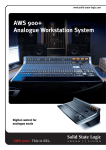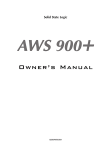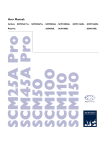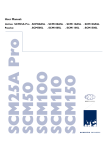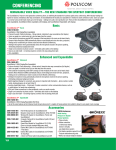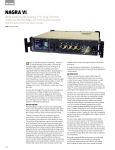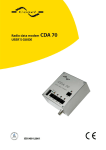Download ATC Group SCM100ASL Specifications
Transcript
TUTORIAL EVERYTHING’S GONE GREEN Reduce your carbon footprint and tread lightly on the Earth by running your studio from solar power. Greg Simmons lights the way… Text: Greg Simmons Climate change… It’s a scary thought, and one that Western society has abruptly acknowledged. It’s hard to say what triggered the sudden shift in attitude, but there can be no doubt that Al Gore’s Academy Award-winning documentary, An Inconvenient Truth, had a lot to do with it: when the former vice-president of the USA goes campaigning around the world on behalf of the world, people pay attention. In the 12 months following its release in May 2006, An Inconvenient Truth did more for the environmental movement than decades of warnings from environmentalists and scientists. It has made even the most stubborn sceptics accept the reality of climate change, and has put the environment firmly on the political agenda. Unfortunately, the problem of climate change can’t be solved by a handful of politicians funding a handful of scientists. The inconvenient truth is that we’re all part of the problem, and therefore we must all become part of the solution. How? By changing the way we consume energy – especially that derived from fossil fuels. As a sound engineer or recording musician, a good place to start is by using solar AT 48 energy to power your audio technology, thereby making ‘green notes’. A solar power system suitable for powering audio technology is shown in Figure 1. It has five components: a solar panel, a battery, a charge controller/regulator, an inverter and a power board. SOLAR PANEL The solar panel consists of an array of photovoltaic cells that convert sunlight into electrical energy. The output is typically 15V DC, but can vary from 12 to 17V depending on the amount of sunlight it is exposed to. Because sunlight varies throughout the day and isn’t available at night, we can’t rely on the solar panel alone to power our equipment. We need a way to store the electrical energy produced by the solar panel so it is available when we want it – the electrical equivalent of making hay while the sun shines, and storing it in the barn. This is where the battery comes into the picture… BATTERY The battery stores the electrical energy produced by the solar panel, and therefore must be rechargeable. There are numerous rechargeable battery technologies available; the two of interest here are lead acid and lithium ion. The lead acid designs offer the highest power per dollar, but their considerable weight makes them best suited to fixed installations. Lithium ion designs are far more expensive but offer very high power per kilogram, making them unbeatable for laptops, mobile phones and other portable technologies. The chosen battery must be designed to have up to 80% of its energy discharged between recharges – this is known as a ‘deep cycle’ battery. Car batteries are not suitable for solar power applications because they are designed for starting motors, situations that typically cause only 5% discharge between recharges. (A car battery won’t last more than a few months if regularly used in a deep cycle situation.) The lifespan of a deep cycle battery is affected by how deeply it is regularly discharged between recharges: the deeper the discharge, the shorter its life will be. It is therefore wise to invest in a battery that can provide all of your powering needs without being discharged to very low levels. Figure 1. A solar-powered SSL studio Solar panel(s) Charge controller / regulator Inverter Powerboard with UPS +12 to +17V DC +12V DC 240V AC 240V AC Laptop Studio A at London’s ‘The Premises’ is an entirely solarpowered recording/mixing studio featuring an SSL AWS900 console, a ProTools HD2 TDM system running from a G5 Macintosh, ATC SCM100ASL and Genelec S30 active studio monitors, a healthy collection of microphones, and a host of outboard from API, Neve, Summit Audio, Thermionic Culture, Lexicon, TLA, Drawmer and TC Electronic. You can read about it here: www.premisesstudios. com/studio-A.html Hard Disk Interface Monitors Earth Rechargeable ‘Deep Cycle’ Battery As with all things in life, rechargeable batteries are not 100% efficient. Deep cycle batteries are typically 90% efficient, which means that 10% of the energy used to recharge the battery is lost in the recharging process – this must be considered when choosing solar panels to recharge the battery. The charge controller/regulator serves two purposes. As a charge controller, it ensures the energy from the solar panel is used to recharge the battery correctly (a switch or menu item selects the appropriate battery technology). As a regulator, it ensures the DC voltage supplied to the inverter from the battery and/or solar panel remains constant. The more expensive charge controller/ regulators include metering to show all input and output voltages and currents. Apart from monitoring the overall performance of the system, this is invaluable for fine-tuning the position of the solar panel(s) for optimum conversion of solar energy. The inverter takes the DC voltage from the charge controller/regulator and converts it to the 240V AC required to power our audio technology. Most inverters have a single power outlet socket, so you’ll need a power board if you want to connect more than one item to the solar power system. Make sure you choose one with enough sockets to power all of your equipment, and allow extra space for any overly-wide AC adaptors that block access to adjacent sockets. It is worthwhile writing ‘solar power’ in clearly visible letters on the power board, not only for identification purposes but to prevent someone from inadvertently plugging a heater or iron into the system and flattening your battery. A power board with in-built UPS (Uninterruptible Power Supply) is a smart investment, because it will provide back-up power to your equipment in the event that your battery runs flat and you want to keep working. A UPS contains a small rechargeable battery and a simple inverter that only come into action when there is a loss of input power. It requires some electrical power to run its internal monitoring circuitry and keep its battery charged, but it’s not significant. Do you need an inverter? If all of your equipment is capable of operating from +12V DC (e.g. a location sound rig for film and television work), you could avoid the expense and efficiency loss of the inverter and power your equipment directly from the charge Lower cost inverters produce an output that is described as a ‘modified sine wave’, which is essentially a poorly filtered 50Hz square wave. These are not recommended for audio work Solar Regulator The UPS sounds an alarm to let you know when it is no longer receiving 240V AC (some ≈ + + + Deep Cycle Battery POWER BOARD While inverters add the convenience of mains power compatibility, there is always a slight loss of power involved in the process of converting DC to AC. This loss defines the inverter’s efficiency, which is typically around 90% (e.g. 10W of power from the battery will produce 9W of power from the inverter). This efficiency loss must be considered when choosing the most appropriate battery for the system. INVERTER Solar Panel An important word about electrical safety: the inverter produces an output voltage of 240V AC, and therefore requires an earth connection to maintain electrical safety. This is not something to be taken lightly – the 240V AC output of a solar power system can kill you just as easily as the mains power. So always consult with a solar power equipment supplier about the most appropriate earthing method for your situation. The more expensive inverters produce a ‘true sine wave’ or ‘pure sine wave’; this is the type of inverter required for audio work. With less than 4% total harmonic distortion, the power supplied by most true sine wave inverters is cleaner than that supplied by the mains, which typically has 5% total harmonic distortion. (When you add to that the audio frequency tones superimposed on the mains to control off-peak hot water services and so on [look up Zellweger/Decabit ‘ripple control protocol’ for more information], ‘wireless’ home intercom systems that use the mains wiring as a signal path, and any other electrical trash picked up on the journey from the power station to your house, the mains power itself ought to be condemned as an audio hazard!) CHARGE CONTROLLER/REGULATOR + controller/regulator. But if you want the convenience of connecting your equipment directly to the solar power system as if you were connecting it to mains power, you’ll need the inverter. because the output voltage contains many oddorder harmonics of 50Hz (e.g. 150Hz, 250Hz, 350Hz, 450Hz, etc.) that can bleed through the power supplies of audio technology and create a buzz in the signal – especially if you’re using budget audio technology that isn’t expecting anything higher than 50Hz from the mains power and therefore has poor rejection of those higher frequency harmonics. A deep cycle battery’s lifespan is also affected by how it is recharged – it is possible to overcharge a battery, thereby reducing its lifespan or destroying it altogether. Each different battery technology has a preferred method of recharging to maintain an optimum lifespan (delivering that preferred method is one of the roles of the charge controller/regulator). Inverter $2000 Powerboard AT 49 will even send a notification to your PC via USB), and ought to keep your equipment running long enough to save your work, disconnect the power board from the inverter and connect it to mains power. Conveniently, this allows all of your equipment to remain connected to the same power board; changing a single plug determines whether your equipment is running from solar or mains power. You won’t be making green notes when running from mains power, but it’s reassuring to know that your commitment to solar power won’t be compromising your creative flow. CHOOSING A SYSTEM The first step in choosing a solar power system is to calculate the total power that your audio technology requires. Start by finding out how much power each individual device consumes, then add up all the individual values to determine the total power requirement. The complete trekking solar power system (folding solar panels, charge controller/battery pack, and inverter) recharging the Nagra V’s internal batteries in a Nepalese village. Pic: Rafaelo Porter The power consumption of each device can be found in the specifications of the equipment, and sometimes it’s printed on the back of the equipment itself. For devices that are powered by AC adaptors, the power rating is often printed on the adaptor. Power is the product of voltage and current, and is usually rated in ‘Watts’ (abbreviated to ‘W’), although some devices will specify it as ‘VA’ (Volt Amps) or even simply as a voltage (Volts or V) and a current (Amps or A). If it is specified as VA, it can be considered the same as Watts for this purpose. If it is specified as a separate voltage and current, multiply the two together to determine the power in Watts (i.e. Watts = Volts x Amps). If you’re not sure how to find this information, ask an electrician or electronics technician for help. AN EXAMPLE CALCULATION & SYSTEM The following example calculates the total power requirement for a laptop-based system built around an IBM ThinkPad T43 with a Seagate Barracuda 3.5 inch external hard drive (500GB, 7200rpm), an MBox 2 Pro audio interface, and a pair of Dynaudio BM5A active nearfield monitors. Greg Simmons watches as Dil Gurung and the horse handler fit the solar panels onto the back of a horse. The battery and charge controller are in a saddle pack. Pic: Mikhael Valeman Practising what I’m preaching I put my first solar power rig together in November 2006, before venturing out on a recording expedition into the Himalaya. I needed a highly portable system with folding or rollable solar panels that could be hung across the back of a pack animal (e.g. a yak, mule or horse) to take advantage of the high altitude sunlight while trekking. Although I wanted to buy locally, I could not find an Australian supplier who catered for my needs. Looking off-shore, I found an excellent system from a US company called CTSolar. It consists of a 32W folding solar panel, a charge AT 50 controller/regulator and a 16A/h battery, all neatly packaged in blue rip-stop nylon. Landed cost was around $850 AUD (including priority delivery). Because it is only intended for charging batteries, a simple 150W modified sine wave inverter from Jaycar ($50) added the finishing touch. It’s more than enough to keep the batteries charged on my recording equipment. The solar panels collect the solar energy during the day’s trekking, and the charge controller stores it in the battery. The stored energy is transferred to the recording equipment overnight, so I start each day with fully charged batteries. When it’s not trekking with me, the system earns its keep in my Nepalese fiancé’s remote village in the foothills of the Annapurna ranges. Her younger brother goes to school in the morning and spends the rest of his daylight hours working in the fields, so he has to do his homework by firelight. My solar power system gives him electric lighting to study by, and runs a portable cassette/radio so he can enjoy his favourite Nepali and Hindi pop songs at the same time. – Greg Simmons Laptop: 60W External hard drive: 10W Audio interface: 6W Active monitors: 30W per monitor (two monitors) This recording system requires 60W + 10W + 6W + 30W + 30W = 136W of power to operate. Because this power will be supplied from the battery via the inverter, we must allow for the inverter’s efficiency, which is typically 90%. So, the total power required from the battery equals 136W / 0.9 = 151.11W, which we can safely round down to 150W. To assemble a solar power system for this laptop-based system, we need to know two more things: how long the system needs to provide power for between recharges (also known as the system’s ‘autonomy’), and how many hours of ‘peak sunlight’ are available for recharging (peak sunlight is required for the solar panel Denis Crowdy’s system for portable multitrack recording I’ve done quite a bit of field recording, and I’ve always been interested in getting decent multitrack recordings rather than the good old ethnographic stereo mic standard. My recording rig is currently built around an Apple Macbook (white model) and the very versatile Metric Halo 2882 MIO, which can be powered from anywhere between +9V to +30V, provided it can draw 16 Watts. It can be powered directly off the Firewire bus (taking power from the laptop’s internal battery) or from a separate supply. I decided to put together a solar power system for a recording expedition I had planned to the Solomon Islands. I pieced things together from on-line ideas, and from calculations suggested by engineers working at appropriate shops. The best response I got was from energymatters.com. au. They have a useful online calculator, and the people I spoke to didn’t baulk when I said I was trying to put together a laptop-based recording studio powered by the sun! My system contains two to produce its best output.). For this example, we’ll assume the system needs to provide power for three hours per day, every day (i.e. autonomy = one day). And we’ll also assume a minimum of four hours of peak sunlight per day for recharging, which is achievable for most residents of Australia throughout the year (according to average hours of sunlight statistics from the Bureau of Meteorology). The information necessary to assemble the solar power system is summarised below: Power: 150W Autonomy: 3 hours per day Peak sunlight: 4 hours per day CHOOSING THE BATTERY A battery’s ability to provide power is measured in Amp/hours (A/h); a figure describing the amount of current it can provide for one hour before going flat. Amps and hours are inversely proportional, so doubling the current would halve the hours and vice versa. Therefore, a battery rated at 10A/h can provide 10A for one hour, 20A for half an hour, 5A for two hours, 1A for 10 hours, or any other realistic combination of Amps and hours that equals 10 when multiplied together. For the example above, the battery must provide 150W of power. To determine the appropriate A/h rating, the first thing we need to know is the battery’s output voltage – from this we can calculate the current required (current = power/voltage). Solar power systems typically use either 12 or 24V battery systems; for the purposes of this exercise we’ll use a 12V battery. To produce 150W from a 12V battery requires a current of 150 / 12 = 12.5A. A 12V battery that can supply 12.5A for one hour will therefore be able to provide 150W for one hour. Now that we know the current required per hour, we can multiply it by the number of hours the system will be used between recharges (i.e. the autonomy). If the system was going to be used for three hours per day, every day, between recharges, then the total A/h requirement of the battery would be 12.5 x 3 = 37.5A/h. 20W solar panels, a charge controller/regulator and a 28A/h battery; total cost was about $800. Powerwise it went well, and we managed a solid five hours or so of recording in a day without any problems. A slightly larger solar panel (say, 60W or 80W) with a bigger battery would allow some pretty solid recording time. It is vital to be organised, so that when the machine is on, you are recording, not fiddling around setting up patches or troubleshooting. Setting up templates in the DAW application is important – inputs, monitoring buses and so on should be ready to roll as quickly as possible. The 2882 was amazing in this respect – it sounds great and allows an impossibly flexible array of routing possibilities. It’s like having a console in the bush, but more flexible! – Denis Crowdy Regular readers will remember Denis from issue 47, where he spoke of his adventures recording stringbands in Papua New Guinea amidst the fallout from an active volcano (‘Songs of the Volcano’). For more information about his solar power system, go: www. motekulo.net/solar.html This figure assumes the battery is going to be fully discharged between charges, which is not healthy for the battery! So we have to factor in the depth of discharging. If we want the battery to have no more than 80% of its energy discharged between charges, its A/h rating will be 37.5 / 0.8 = 46.88A/h, which we’ll round up to 47A/h. In other words, a 12V battery rated at 47A/h can provide 150W of power for three hours, and still have 20% of its charge remaining. This is the minimum battery capacity required to run the system in the example for three hours. If the budget allows it, a larger battery is a better choice because it requires less discharge depth and will therefore have a longer life. It would also allow greater autonomy in the event of an overcast or rainy day with less than sufficient sunlight. CHOOSING SOLAR PANELS The solar panel’s job is to replace the power taken from the battery. To determine the appropriate solar panel, we need to know a) how much power has been taken from the battery, b) how many hours of peak sunlight we can expect per day for recharging, and c) the battery’s efficiency. Because the voltage and current produced by a solar panel varies with the amount of sunlight, we cannot use Amp/hour figures reliably. Instead, we use Watt/hours (W/h). In the example above, the audio technology drew 150W from the battery for three hours, making a total of 150 x 3 = 450W/h. We chose a conservative figure of four hours per day of peak sunlight, which means the solar panel must produce 450/4 = 112.5W per hour. In other words, a solar panel rated at 112.5W would recharge the battery after four hours of peak sunlight – but only if the battery was 100% efficient, which it is not. Factoring in a typical battery efficiency of 90% means the solar panel must produce 112.5/0.9 = 125W per hour. A 125W solar panel would recharge a 90% efficient battery with 450W after four hours of peak sunlight. A more expensive 250W panel AT 51 “Taking advantage of on-line purchasing discounts from local suppliers, a suitable system can be purchased for approximately $2000 AUD.” 12 or 24 Volts? As calculated in the example, a 12V battery must provide 12.5A to the inverter. That’s a significantly high current and will require heavy-duty wiring between the battery, charge controller/regulator and the inverter. If a 24V battery and inverter were chosen, this current would halve. Here’s the maths: to produce 150W from a 24V battery requires a current of 150 / 24 = 6.25A. So, a 24V battery that can supply 6.25A for one hour will be able to provide 150W for one hour. Because the system will be used for three hours per day, every day, the total A/h requirement for a 24V battery is 6.25 x 3 = 18.75A/h. Factoring in a maximum discharge depth of 80% means the total A/h requirement of the 24V battery would be 18.75 / 0.8 = 23.4A/h, which we’ll round up to 25A/h. For smaller systems, like the one in this example, 12V technology is usually the most cost-effective. With larger systems, 24V technology may prove to be more cost-effective. would recharge the battery after just two hours, while a cheaper 62.5W panel would require eight hours. Solar panels are available in many different sizes and power ratings. Sometimes it is not possible to get a single solar panel with sufficient output power. In this case, two or more solar panels can be connected together in parallel. The example above required a solar panel rated at 125W. A single 125W solar panel would do the job nicely, but other combinations are possible. Two 60W solar panels wired in parallel will produce 120W. Likewise, four 30W solar panels wired in parallel will also produce 120W. (Both of these examples represent a shortfall of 5W per hour, or a total of 20W during the four-hour peak sunlight recharging period. This is acceptable because the panels will almost certainly be exposed to more than four hours of sunlight per day, allowing them to make up the difference – a 120W panel will produce the extra 20W in 10 minutes of additional peak sunlight.) The ability to combine solar panels has another benefit if the budget is tight. For the example above, it may be possible to start with a single 60W solar panel and add a second solar panel when the budget permits. The downside is that a 60W solar panel will take longer to recharge the battery. If, however, you lived in an area that got considerably more than four hours of peak sunlight per day, a 60W solar panel might be sufficient. Likewise, if the audio technology was only used on alternating days (e.g. Monday, Wednesday, Friday, etc.), a 60W solar panel would have plenty of time to recharge the battery. If the audio technology was only used one day per week (e.g. Saturdays), an inexpensive 30W solar panel would have plenty of time to recharge the system during the week. One final note: The effectiveness of a solar panel is affected by its physical positioning in relation to the movement of the sun across the sky. Careful positioning is required to maximise the output power. This is where the voltage and current indicators provided on the more expensive charge controller/regulators come in handy – by monitoring the output voltage of the solar panels, it’s possible to fine-tune their position for optimum output power. CHOOSING THE OTHER PARTS… Now that we know the battery and solar panel requirements, we must consider the devices that interface them together and to the audio technology they are powering: the charge controller, the regulator, the inverter and the UPS power board. The charge controller must be able to withstand the highest current the solar panel is capable of producing, which is known as its ‘short circuit current’. Incorporating a safety factor of 1.5 ensures the charge controller is never pushed to its maximum capability. So, if the solar panel’s short circuit current is 5A, a charge controller/ regulator rated at 5 x 1.5 = 7.5A would be a good choice. (Note that if you are using two or more solar panels in parallel, you must add the short circuit currents together to arrive at a total, AT 52 which the safety factor is then applied to.) The regulator must be able to pass current from the battery to the inverter without being damaged from overheating. The system used in the example above drew a total of 12.5A from the battery – the regulator must be capable of passing this current. Again, a safety factor of 1.5 is worth considering, suggesting a minimum of 18.75A, which we’ll round up to 20A to suit commercially available products. Likewise, the inverter must be able to accept this current from the regulator and deliver 136W of AC power to the audio technology – a 150W inverter would be the minimum choice for this purpose, but a 200W inverter would be wiser. The wiring used to interconnect all the components must also be considered. Solar power systems are low voltage systems, and that means they need much higher currents to produce power. The 12V system described here needs 12.5A of current to produce 150W of power. In comparison, a 240V AC system needs only 0.416A to produce the same power. Passing 12.5A of direct current (DC) through a wire safely and efficiently requires heavy-duty wiring – even the power leads used for domestic appliances are insufficient for this application. This is why the wiring used for car batteries is so thick; a larger diameter wire has less resistance, and is therefore capable of passing a higher current with greater efficiency and safety. If the wire is too thin and has too much resistance, it will create a voltage drop (resulting in a loss of power) and may even overheat and cause an electrical fire. The companies that provide solar power equipment can recommend suitable wiring. The UPS power board must provide sufficient back-up power to keep the audio technology running for about 10 minutes; more than long enough to save your work and either shutdown or change over to mains power. For the example given here, the UPS should be able to provide 136W of power for 10 minutes. Most UPS power boards come with a chart showing how long they can power different systems. A PRACTICAL SYSTEM The audio technology used for this example is typical of the smaller systems used in project studios. Based on the calculations above, the minimum requirements to power this system are: 1 x 125W solar panel 1 x 47A/h deep cycle battery 1 x 20A charge controller/regulator 1 x 150W inverter 1 x UPS power board Taking advantage of on-line purchasing discounts from local suppliers, a suitable system can be purchased for approximately $2000. This cost may seem high, but remember that the calculations used very conservative figures, erring on the side of caution, to propose a solar power system that should reliably provide three hours of power per day, every day – along with UPS back-up for easy transfer to mains power Horse Power: Marc Peckham’s self-sufficient setup includes four solar panels, 12 batteries within the float and a wind turbine to top things up during the breezy evenings. His container-based studio packs a collection of hip hop favourites such as an Akai MPC3000 as well as a few novelties, including a Levy’s Sound Studios Pultec EQ copy that Jimi Hendrix recorded his guitar through for Are You Experienced? (the actual unit). ANYONE CAN MAN A hip hop studio in a shipping container… powered by solar panels mounted on a horse float?! Read on. The Aussie hip hop community has little in common with its US counterpart. Bling and a ‘get rich or die trying’ ethos are replaced by groups with barely a dollar to their name and a heart for the fringe. It’s this ground that Welsh-born Marc Peckham, aka Monkeymarc, treads loud and clear. On the spend of mostly private funding, Peckham travels to the The Western Desert and Kimberley region for six months of the year to help Aboriginal community elders impart knowledge to the younger generations in a form relevant to the times. Along the way he also documents field recordings of their traditional songs, and when he’s not in The Kimberley, Peckham is home in Abbotsford remixing the likes of The Herd and making music in his band, Combat Wombat. Global warming might be the issue du jour, but back since 1998 Marc’s been considering how he can make a difference. The impetus behind his solar experimentation was to prove that ‘alternative’ living and a ‘zero impact’ isn’t some magical proposition out of reach of the layman. It’s something he has learnt from scratch, and has worked up from a four-wheel bicycle contraption used to power parties to the solar panelled horse float that powers his Abbotsford studio today. The studio itself is housed in an old refrigerated shipping container, and he’s been given special dispensation by mother superior to park it in the grounds of the Abbotsford Convent. Furnished with wood from an old indoor netball court, and treated with Rockwool and foam baffles, the aluminium container came out a treat. The equipment list required to power the container and its gear involves 12 x 24V batteries, four solar panels, a 240V inverter and a small wind generator to top up the power overnight when the sun goes down. The setup comfortably powers his studio for eight to 10 hours at a time, with a break on weekends to let the batteries return to their maximum. And if that’s not enough, Peckham estimates he could power a 3000W PA for eight hours with his solar trailer. Not a bad effort. He is looking to expand his system with another four solar panels to get through the Melbourne Winter, an understandable notion given the grey clouds on the day of the interview. And the reasoning behind the horse float? Well, a shipping container doesn’t afford much space, and a couch full of batteries isn’t exactly comfortable. Plus, there’s the added benefit of being able to pull around power, and if the Convent decides Combat Wombat should move on, then a simple car hookup and Peckham can follow the container wherever it may go. – Mark Davie if necessary. We must also bear in mind that it’s an ambitious system because it attempts to power the studio monitors, which add significantly to the total power consumption (60W of the total 136W, or 44%), and therefore to the cost. It would be possible to start with a smaller system that powered everything except the studio monitors, for an initial investment of approximately $1000, and add more solar panels and/or batteries as funds permit to gradually migrate your entire studio to solar power. (As with solar panels, batteries can be connected together in parallel to increase the total current capability.) Connecting with the earth Going green may be ‘earthier’ than you think: the inverter used in the solar power system described here produces an output voltage of 240V AC, and therefore requires an earth connection to maintain electrical safety. This is not something AT 54 to be taken lightly – the 240V AC output of a solar power system can kill you just as easily as the mains power. So always consult your solar equipment supplier about the most appropriate earthing method for your situation. It is also important to remember that the solar power system described here is powering a laptop computer with a consumption of 60W. This figure includes the power required to charge its internal battery, in which case it is simply transferring electrical energy from one place to another. Once it is fully charged, the laptop could be disconnected from the solar power system and powered from its internal battery, thereby extending the power capability considerably beyond three hours. LET THE SUNSHINE IN! Australia is blessed with an abundance of solar energy, and an abundance of solar power technology suppliers. Most have helpful staff and informative websites; some even include on-line calculators to help you choose the most appropriate equipment. Always discuss your solar power system with a supplier to ensure it will be correctly rated and properly earthed. For more information, log on to AudioTechnology’s website and download the resources to accompany this article (follow the links). These include Excel spreadsheets with lists of power requirements for common items of studio equipment, calculators to help determine the best solar power system for your needs, recommended systems, and links to local solar power technology suppliers. By converting to solar power, you’ll be joining a growing list of artists around the world who are producing green notes. So what are you waiting for? Go green, go clean, and become part of the solution!







